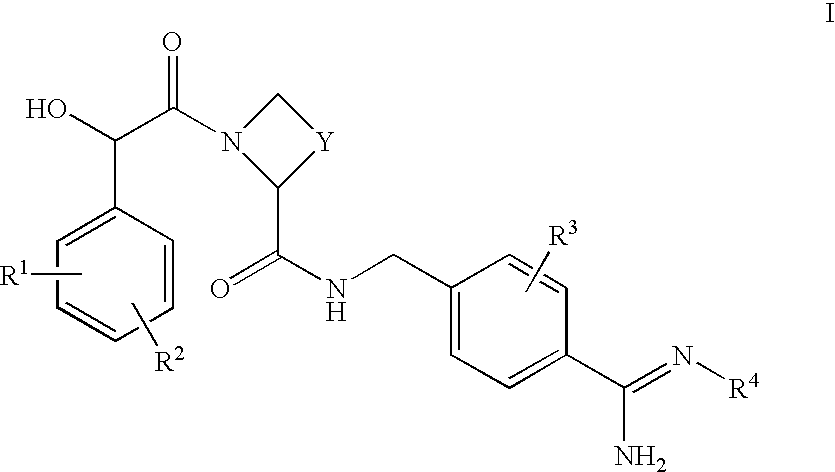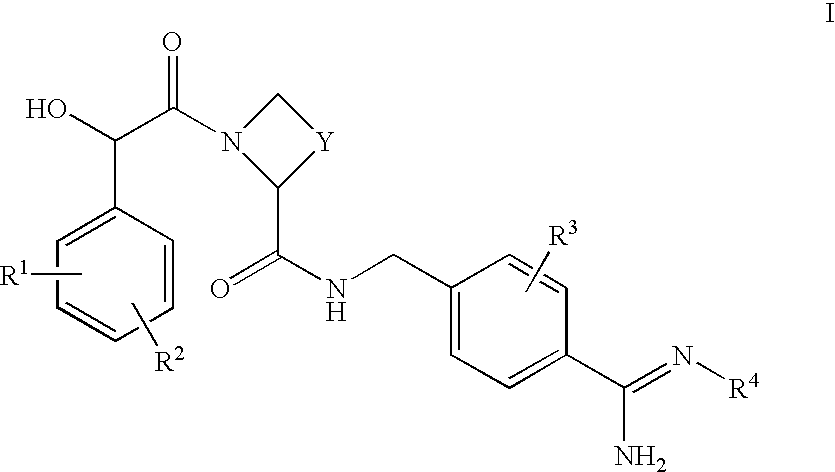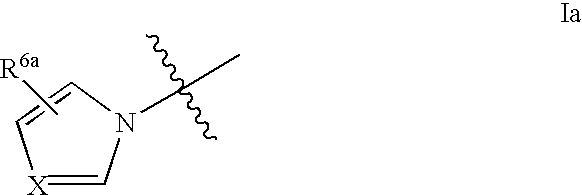Amidinobenzylamine derivatives and their use as thrombin inhibitors
a technology of amidinobenzylamine and derivatives, which is applied in the direction of drug compositions, peptide/protein ingredients, extracellular fluid disorders, etc., can solve the problems of thromboembolic diseases, the need for protecting groups, and the inability to protect groups
- Summary
- Abstract
- Description
- Claims
- Application Information
AI Technical Summary
Benefits of technology
Problems solved by technology
Method used
Image
Examples
example 1
Ph(3-N(Me).sub.2)-(R)- or -(S)CH(OH)--C(O)-Aze-Pab.times.HOAc
(i) Ph(3-N(Me).sub.2)--CHO
A mixture of Ph(3-N(Me).sub.2)--CH.sub.2 OH (1.9 g; 12.6 mmol) and MnO.sub.2 (8.8 g; 100 mmol) in CH.sub.2 Cl.sub.2 was stirred at room temperature for 2.5 days. The mixture was filtered through Celite.RTM. and the filtrate was evaporated. The crude product was flash chromatographed on silica gel using iso-propylether:trimethylpentane (7:3) as eluent. Yield 0.93 g (50%).
.sup.1 H-NMR (400 MHz; CDCl.sub.3): .delta. 9.89 (s, 1H), 7.37 (m, 1H), 7.17-7.25 (m, 2H), 7.05 (m, 1H), 2.98 (s, 6H).
(ii) Ph(3-N(Me).sub.2)-(R,S)CH(OSiMe.sub.3)N TMS-CN (0.75 mL; 6.0 mmol) was added dropwise to a mixture of Ph(3-N(Me).sub.2)--CHO (0.9 g; 6.0 mmol; from step (i) above) and Et.sub.3 N (0.08 mL; 6.0 mmol) in CH.sub.2 Cl.sub.2 (15 mL). The reaction mixture was stirred at room temperature for 24 hours. Additional Et.sub.3 N (0.08 mL; 6.1 mmol) and TMS-CN (0.75 mL; 6.0 mmol) were added and the stirring was continued for...
example 2
Ph(3-N(Me).sub.2)-(R)- or -(S)CH(OH)--CO-Aze-Pab(OMe)
(i) 4-(Amino, Methoxyiminomethyl)benzyl Azide
A mixture of O-methylhydroxylamine hydrochloride (10.5 g; 125 mmol), triethylamine (56 mL) and methanol (200 mL) was added to 4-ethylimidatobenzyl azide hydrochloride (22.5 g; 110 mmol; prepared according to the method described in WO 94 / 29336) in diethyl ether. The reaction mixture was stirred at room temperature for 3 to 4 days. Most of the methanol was removed in vacuo and replaced with ethyl acetate. The organic layer was washed with H.sub.2 O, HOAc / aq (1.5%; pH 4), NaHCO.sub.3 / aq and dried (Na.sub.2 SO.sub.4). The resultant solution was diluted with ethyl acetate to 500 mL, and 25 mL of the diluted solution was concentrated to estimate the yield. The total yield was about 20 g.
.sup.1 H-NMR (400 MHz; CD.sub.3 OD): .delta. 7.66 (d, 2H), 7.36 (d, 2H), 4.37 (s, 2H), 3.83 (s, 3H).
(ii) H-Pab(OMe)
Platinum oxide (200 mg) was added to a solution of 4-(amino, methoxyiminomethyl)benzyl azide...
example 3
Ph(3-SMe)-(R)- or -(S)CH(OH)C(O)-Aze-Pab.times.TFA
(i) Ph(3-SMe)-(R,S)CH(OTMS)CN
To a solution of Ph(3-SMe)--CHO (19.8 g, 130 mmol) and ZnI.sub.2 (2.1 g, 6.50 mmol) in CH.sub.2 Cl.sub.2 (450 mL) at 0.degree. C. under nitrogen there was added dropwise trimethylsilyl cyanide (14.2 g, 143 mmol). After stirring overnight at 25.degree. C., the orange mixture was quenched with H.sub.2 O (450 mL). The organic layer was separated and washed with saturated brine (300 mL), dried (Na.sub.2 SO.sub.4), filtered and concentrated in vacuo to give 32.0 g (98% crude) of the sub-title compound as an orange oil which was used without purification.
.sup.1 H NMR (300 MHz; CDCl.sub.3): .delta. 7.20-7.41 (m, 4H), 5.50 (s, 1H), 2.51 (s, 3H), 0.23 (s, 9H).
(ii) Ph(3-SMe)-(R,S)CH(OH)C(O)OH
A solution of Ph(3-SMe)-(R,S)CH(OTMS)CN (32.0 g, 130 mmol; see step (i) above) in concentrated HCl (250 mL) was refluxed for 2.5 h. The mixture was made basic with 6 N NaOH (450 mL) and washed with Et.sub.2 O (3.times.300 mL) t...
PUM
| Property | Measurement | Unit |
|---|---|---|
| Pharmaceutically acceptable | aaaaa | aaaaa |
Abstract
Description
Claims
Application Information
 Login to View More
Login to View More - R&D
- Intellectual Property
- Life Sciences
- Materials
- Tech Scout
- Unparalleled Data Quality
- Higher Quality Content
- 60% Fewer Hallucinations
Browse by: Latest US Patents, China's latest patents, Technical Efficacy Thesaurus, Application Domain, Technology Topic, Popular Technical Reports.
© 2025 PatSnap. All rights reserved.Legal|Privacy policy|Modern Slavery Act Transparency Statement|Sitemap|About US| Contact US: help@patsnap.com



